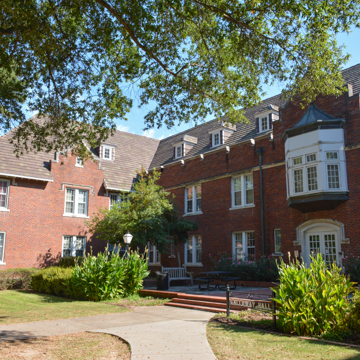Galloway Hall was the first of two similar dormitories Thompson designed for Hendrix College; the other was Martin Hall in 1918. Martin housed boys, and Galloway accommodated girls. Both are three stories in height, built of dark red brick with white limestone trim, and Tudor Revival in style. Galloway has an oriel window over the entrance. As was often the case at coeducational college campuses in the late nineteenth and early twentieth centuries, the boys’ dormitory was placed near the center of campus activity, whereas the girls’ building was secluded at the periphery. Hendrix College, a liberal arts institution, has its origins in the Central Collegiate Institute founded in Altus. Purchased in 1884 by the Methodist Episcopal Church South and in 1889 renamed Hendrix in honor of the Reverend Eugene R. Hendrix, the college moved to Conway in 1890. In general, the campus buildings are arranged around quadrangles or courtyards and set among many mature trees.
Thompson also designed the President’s House (1913), a dark red brick two-story building displaying Craftsman features, including multipaned casement windows and a front porch supported on Tuscan columns sheltered under a pergola-like roof with rafter ends. George Currie, a Latin teacher on the faculty, designed the Young Memorial (1920), which commemorates World War I casualties from Hendrix College. The marble monument (Currie’s father was a marble dealer) is composed of a bench set in a half-circle, and its high back is carved with allegorical female figures of Peace and Liberty and, at the center, a life-sized statue of an American doughboy.


